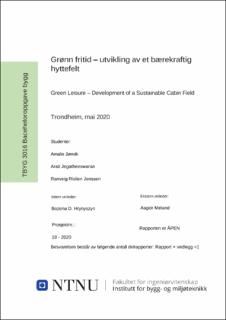| dc.description.abstract | Denne bacheloroppgaven er utarbeidet på vegne av oppdragsgiver Grønn Fritid AS. Oppgaven er en videreutvikling av oppdragsgivers idé vedrørende prosjektering av et bærekraftig hyttefelt med fellesfunksjoner. Arbeidet er ment som et bidrag til fremtidens hyttekultur og kan brukes videre i arbeidet mot et grønt skifte i fritidsbolignæringen. For å utarbeide en løsning til konseptet ble følgende problemstilling formulert; «Utvikling av et arealeffektivt og fremtidsrettet hyttekonsept med bærekraft som prioritet». Oppgaven resulterer i et konkret forslag til hvordan et slikt hyttekonsept kan utformes.
For å vurdere bærekraftighet, er ulike materialer og konstruksjonsprinsipper vurdert opp mot hverandre. Dette inkluderer også drøfting av ulike fundamenteringsmetoder for å finne metoden som bevarer mest mulig vegetasjon. Andre aspekter ved bærekraftperspektivet det er tatt hensyn til, er hvordan konseptet kan utformes hensiktsmessig med tanke på redusert areal og delte fellesfunksjoner, diverse miljøvennlige energiløsninger samt hvilken energistandard bygningene skal prosjekteres etter.
Resultatet ble utforming av et hyttefelt bestående av ni kompakte hytter på 35 m2 BRA hver og et fellesbygg på omkring 130 m2 BRA. Fellesfunksjonene som ble vurdert hensiktsmessig, var boblebad, badstue, tørkerom, dusjfasiliteter, gjesterom, felles stue og kjøkken, boder, utstyrsverksted, naturlekeplass, grillutstyr og gapahuk med bålplass.
Ved å ivareta bærekraft som tungtveiende prioritet i prosjektet, ble det konkludert med å benytte mest mulig norskprodusert trevirke i bygningene. For å bevare vegetasjon ble det besluttet å benytte åpen fundamentering med pæler. Bygningenes energistandard ble bestemt til å ligge på energikravene i TEK17 som gjelder for fritidsboliger mellom 70 m2 og til og med 150 m2 oppvarmet BRA. Når det kommer til energiløsninger, ble blant annet peisovn, varmepumpe og vannbåren varme valgt. Dette resulterte ifølge simuleringer til energimerket lysegrønn A.
Oppgaven har vært nødt til å avgrenses noe, og en mer omstendelig analyse av materialvalg der livsløpsperspektivet tas med kan derfor være nyttig for videre arbeid. Til slutt i oppgaven ble det gjort en kostnadsanalyse. Denne viser at kostnad for hver hytte, inklusiv delt kostnad på fellesbygget, vil komme på like under 1,7 millioner kroner. | |
| dc.description.abstract | This bachelor thesis is written on behalf of Grønn Fritid AS. The thesis describes a sustainable cabin field with shared facilities and is based on an idea developed by the company. The intention behind the project is to contribute to the development of provident cabin fields, which has an increasing focus on sustainability. To find a solution to this concept, the topic has been formulated as following: “Development of an area efficient cabin concept for the future with sustainability as a priority”. The thesis results in a concrete suggestion in how the cabin concept can be designed.
To make sure sustainability is the main priority, different materials and solutions have been compared to each other before any final decisions were made. This also included discussion on several foundation methods to find the one that preserves as much as possible of the vegetation. Other sustainable aspects that have been taken into consideration, are how the concept can be designed to make the area in the cabins efficient and finding appropriate shared facilities. It has also been discussed which energy solutions and energy efficiency standard the project should have in order to be as sustainable as possible.
It was, as a result of the topic’s winding, chosen to design and develop a cabin field containing nine, compact cabins of 35 m2 utility floor space in addition to a bigger, shared cabin around 130 m2 utility floor space. Some of the shared facilities that was concluded to be convenient for the common cabin was showers, a sauna, a jacuzzi, a common living- and dining space, a shared kitchen and a guest bedroom. In addition, some facilities for the outdoor area was also chosen expedient, such as an outdoor storage for each owner, a workshop for both winter- and summer equipment, a playground for children, barbeque facilities and a lean-to shelter with possibilities for bonfires.
By assuring sustainability as weighty priority, the project looked at the use of Norwegian- and locally produced materials. In order to preserve the vegetation on the property, it was decided to use open foundation with piles. The energy efficiency standard of the buildings was set to meet the requirements of TEK17, which only apply to leisure homes between 70 m2 and 150 m2 utility floor space. When it comes to energy solutions regarding heating, some of the choices were eco-designed wood-burning stoves, heat pumps and water born heating-systems. According to simulations, these choices resulted in the energy label light-green A.
It was, in some areas, necessary to refine the thesis. For further work, it would be useful to include a detailed analysis of the life cycle perspective of the chosen materials. At last, it was developed a cost analysis of the entire project. This analysis indicates that each cabin, including the costs of shared building and facilities, will get a value right below 1.7 million NOK. | |
